.
Moorland in the Desert of Wales as seen from the summit of Drygarn Fawr: photo by Velela, 29 March 2009
It was like a church to me.
I entered it on soft foot,
Breath held like a cap in the hand.
It was quiet.
What God there was made himself felt,
Not listened to, in clean colours
That brought a moistening of the eye,
In a movement of the wind over grass.
There were no prayers said. But stillness
Of the heart’s passions -- that was praise
Enough; and the mind’s cession
Of its kingdom. I walked on,
Simple and poor, while the air crumbled
And broke on me generously as bread.
R. S. Thomas: The Moor, from Pietà, 1966

Tussocks tussocks tussocks. This literally is all there is in this square: tussocks of rough grass, some of it fairly dry (as in the centre of the pic), some more of the reedy sort (as pictured on the left). The land falls off towards the east and south to the source streams of the Afon Tywi. Tussocks!: photo by Rudi Winter, 12 April 2007
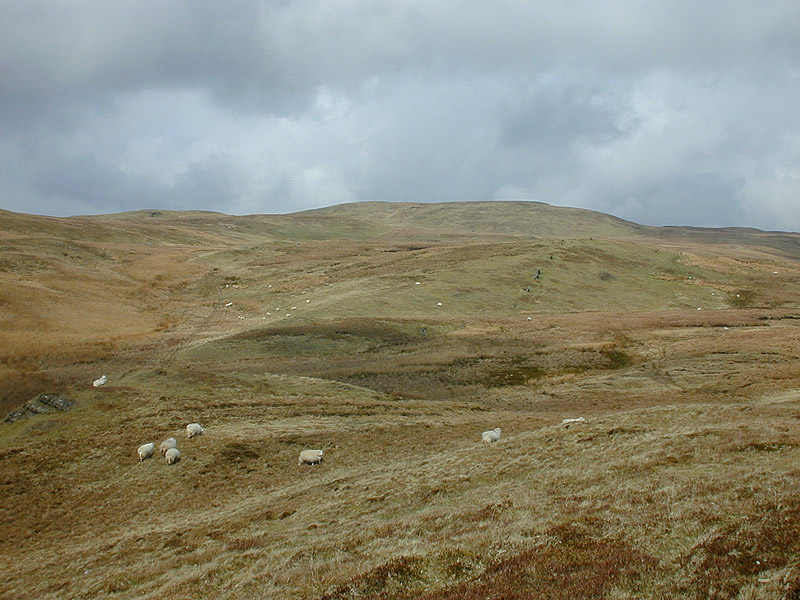
Moorland south of Llan Ddu Fawr. The moor climbs steadily towards Llan Ddu Fawr. With a bit of care, the few wet bits can be avoided: photo by Nigel Brown, 12 April 2004

Moorland northeast of Llan Ddu Fawr (2). Looking towards Carnyrhyrddod from near the summit of Llan Ddu Fawr. The peat hags in the middle between the two can be avoided by following an arc to the left. The "Llan" in the name is a corruption of "Lan", short for "Glan", meaning hillside in this context: photo by Nigel Brown, 12 April 2004
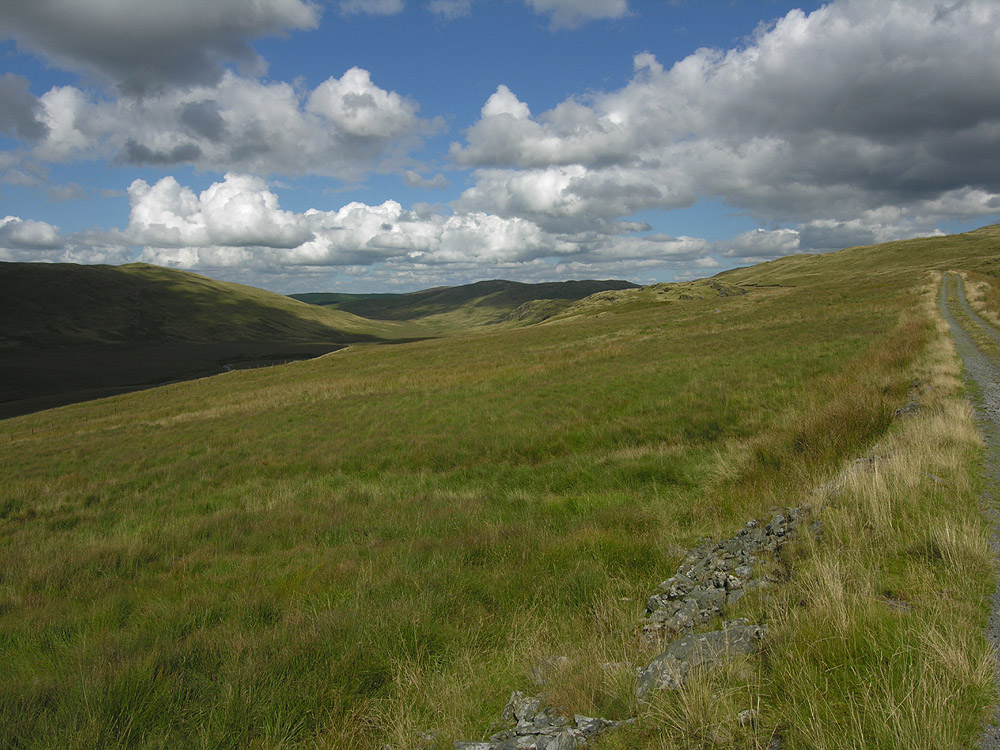
Lower slopes of Plynlimon. The track which ends at Llyn Llygad Rheidol passes through typical moorland on the lower slopes west of Plynlimon: photo by Nigel Brown, 2 September 2005
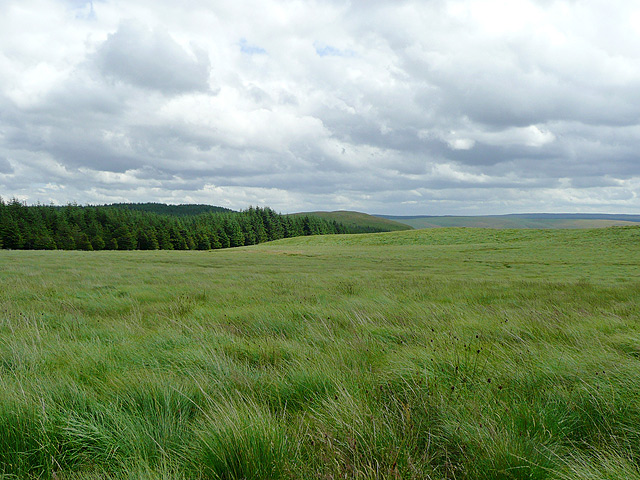
Elenydd moorland west of Pysgotwr, Ceredigion. Beyond the nearby moorland and forest (on Llethr Gwyn) the terrain drops steeply into Cwm Pysgotwr: Photo by Roger Kidd, 13 July 2009
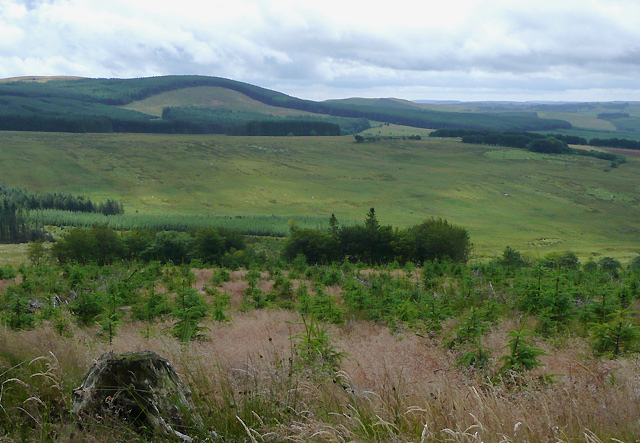
Elenydd landscape south of Llanddewi-Brefi, Ceredigion. Looking across the wide valley of Nant Clywedog-uchaf: photo by Roger Kidd, 18 July 2009

Elenydd Landscape from Carn Penrhiwllwydog, Ceredigion. Across the Doethie valley, the drovers' road climbs from left to right, on its way to Soar-y-Mynydd. To the right of centre, Nant y Benglog plunges down towards the Doethie Fawr. On the skyline to the left is the summit of Drygarn Fawr (height 641 metres -- 2103 feet) 7 miles distant (12.5km): photo by Roger Kidd, 18 September 2007

Elenydd Landscape from Bryn Mawr, Ceredigion. Much of the land here is now designated "open access", which is not to the liking of some landowners on the south side of the Doethie Fawr. Walkers are advised to comply correctly with access regulations in this area: photo by Roger Kidd, 18 September 2007
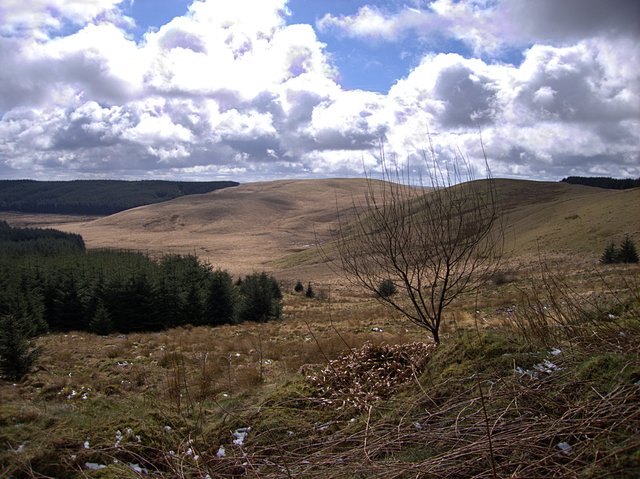
Edge of Tywi Fechan forest. Looking from the edge of the forest (which is a little north from where the map suggests due to felling) onto the open moorland to the south. The two parallel ridges are Cefn y Cnwc (centre) and Pen y Maen (right/west): photo by Rudi Winter, 24 March 2008
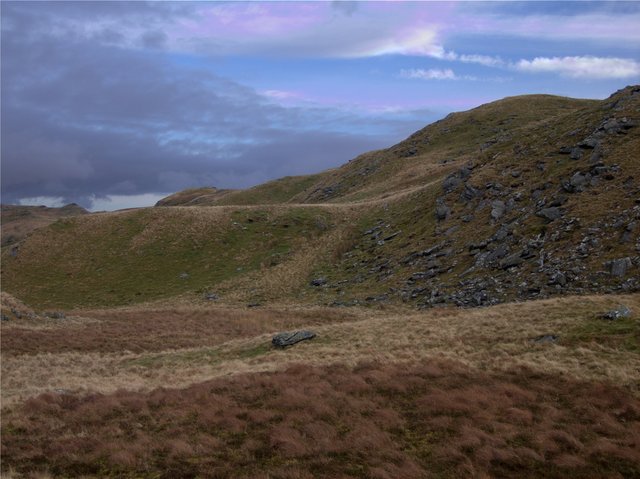
Disgwylfa. Standing on the bwlch between Craig y Pyllauduon and Disgwylfa and looking towards the head of Cwm Teifi. The grassy summit to the right is Disgwylfa, at 459m the highest point in the area: photo by Rudi Winter, 12 January 2008

Craig y Pyllauduon Looking from Craig y Frongoch towards Craig y Pyllauduon across the boggy valley from which the Nant Dderwen originates. Craig y Pyllauduon is probably named after the bog on its side -- the rock of the black pools. However, it's easy to circumnavigate the quagmire: photo by Rudi Winter, 12 January 2008

Berthgoed ridge. The small ridge on the side of this moorland plateau is shown on the 1:25k map as two parallel crags. There are a few rocks sticking out but most of it is covered in the usual grassland. The northern half of the square contains the steep south flank of Cwm Mwyro, the SW corner is part of Strata Florida forest. The remaining high ground is an undulating moorland plateau as shown here: photo by Rudi Winter, 12 April 2007
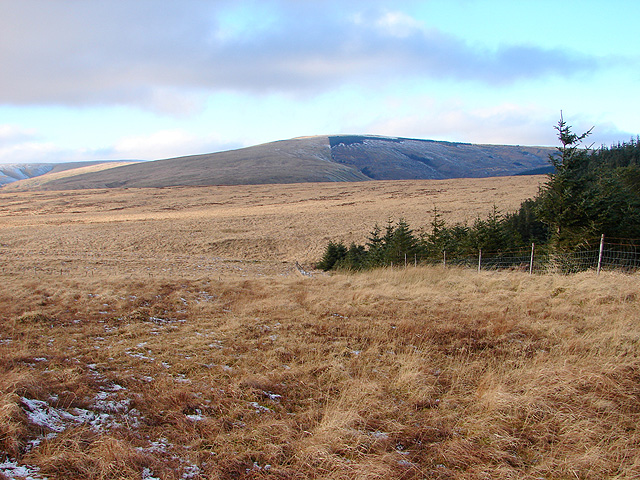
A view towards Waun Goch and Bryn Daith. Seen here from the south-west boundary of Hafren Forest. A right of way runs across the Waun Goch moorland and beneath the slopes of Esgair y Maesnant (out of view on the right), towards the old Bryn Daith mine: photo by OLU, 8 January 2009
The Drybedd ridge. Looking along the ridge west of the summit of Drybedd. The pathless ridge fills the NE half of the square, with the Hirnant valley taking up the opposite corner. All of this is wild moorland used, if at all, for rough grazing. The Nant y Moch dam can be seen on the right in the distance: photo by Rudi Winter, 1 April 2007
Above Gwar-Cwm: photo by Chris Denny, 26 October 2008


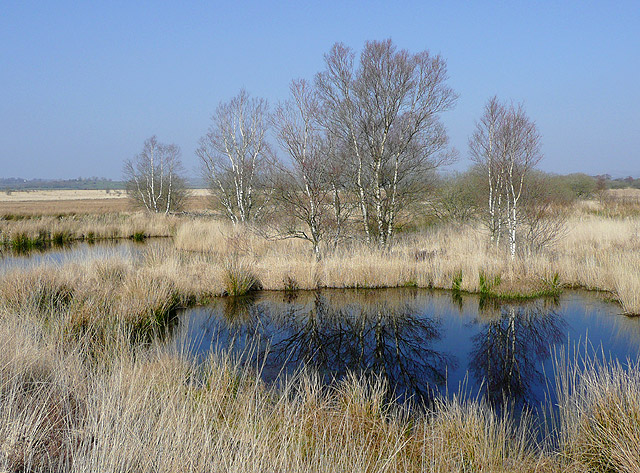
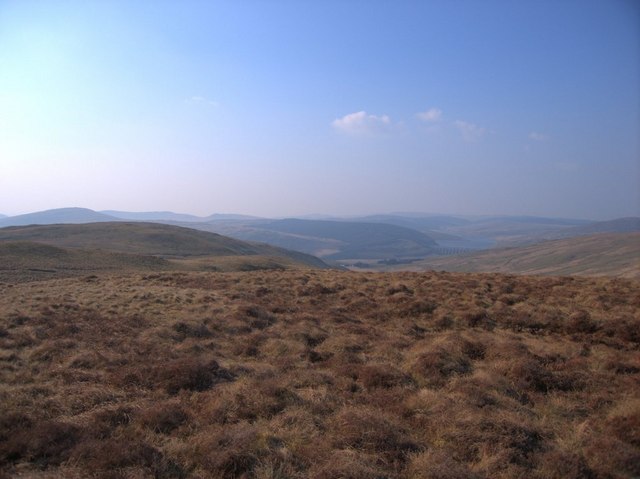
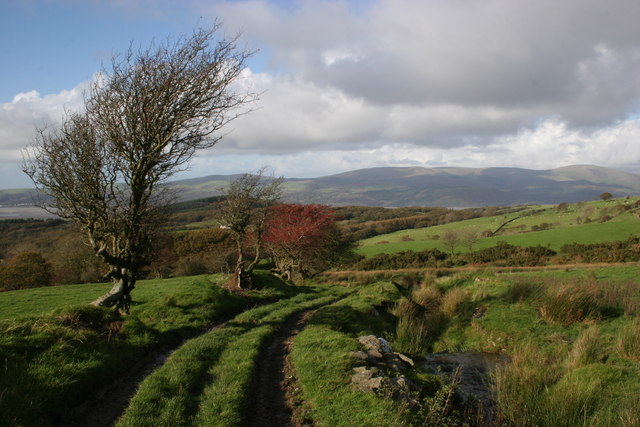



16 comments:
I was reading this poem and looking at those pictures and lost all sense of place.
The beauty here is stripped of all sentiment; it's the wind that brings tears to the eyes.
"the mind's cession of it's kingdom"
R. S. Thomas doesn't pull the scene to himself with imperious fingers. It all comes as grace.
I'm moved and wholly thrown.
The moorlands pictured in this post (or others similar) would have been the prominent landscape features of the countryside about the parsonage Thomas occupied, and from which he embarked on his walks, in the period when he was writing the poems (like this one) collected in Pièta, 1966
Some interesting further glimpses:
R. S. Thomas, 1995
R. S. Thomas: The Bright Field (read by Nicola Davies)
The intense, amplified blue of the water catches the eye in that photo of Car Caron. Gorgeous photos, all of them, and Thomas’ words too. Being there. What a beautiful place Earth is. Wilhelm Reich said, ‘Sensation is the greatest mystery of natural science.’
espacios maravillosos...imposible no sentirse invadido de fuertes emociones...
wonderful metaphor:
Simple and poor, while the air crumbled
And broke on me generously as bread.
"‘Sensation is the greatest mystery of natural science.’"
"R. S. Thomas doesn't pull the scene to himself with imperious fingers. It all comes as grace."
"espacios maravillosos...imposible no sentirse invadido de fuertes emociones..."
Texts for a quiet spring sermon upon the holy minimalism of vacancy. The less there is of everything, the more there is of Everything.
Tom,
Lovely photos, through which "I walked on,
. . . while the air crumbled" -- in my imagination at least, being here in Greenpoint visiting Oona (soon to have a baby), somewhere between those coastal hills of Bolinas ('pictured' here in yesterday's poem) and the "tussocks of rough grass" of Ceredigion.
6.14
light coming into sky above still black
ridge, white curve of moon above branch
in foreground, wave sounding in channel
rare self portrait of a man,
flat side of building
changed, the sleeping woman,
bird in minute detail
first silver of sun rising above ridge,
shadowed green pine on tip of sandspit
Steve, hope all goes well there with Oona and all is well with you as well -- Greenpoint, that's really changing the channels!
Sacred open spaces with much activity in the grasses, water, sparse trees and sky. Even the rocks have their certain personalities and speak, saying much while appearing so still. I like the red lipstick of the tree (last photo). "...I walked on," how could one? I am just possibly beginning to understand (everything) here in the Desert of w's, of y's.
i believe i once found a similiar spirituality in your home where somehow even the sielnces took on their own language...
I like to think that blotch of red in the last picture is a Judas tree, a supposition highly unlikely, given its geographical distribution.
I realize I'm late to this party and to knowledge of R. S. Thomas, whose life I've just been reading about. Regarding this post, it's funny the way the only thing that breaks the silence are Thomas's words. What a beautiful poem. Unique. I visited at a good moment because yesterday was filled with far too many noisy, mostly dishonest words and I woke up still hearing them. Steve's last two poems have been wonderful to read also. Curtis
Sefyll ar y bwlch -- definitely the place to be.
All these wondrous photos didn't show up for me until today. I have not yet read Thomas's bio or autobiographies but his poems are each as beautiful as the scenes and in some of the same ways. The lush green and forested ones surprised me as most I've seen leave me in awe of the sheep and the shepherds RST celebrated and elegized, true survivalists (like him). I'm indebted to Welsh-bred Bristol artist-poet-blogger Dru Marland (fitting name) for introducing me to Thomas's life and work.
http://dru-withoutamap.blogspot.com/
Larry, I picked up a taste for Thomas's poems when living in the UK in the 1960s -- he seemed from then on a rare pure source in that area of the meditative lyric in which English language poetry has for so long excelled but which it has increasingly abandoned what with the latterday embrace of data, deconstruction, dumbness and other deleteriously invasive imports. The general collapse may have begun with transatlantic flight, or was it the Chunnel, or the Web.
In the 1960s one of the poets I enjoyed reading was Thomas Clark, Tom! Back when I frequented the 8th St., the Phoenix, and St. Mark's Place bookshops. The Robert Graves interview in Paris Review dramatically turned my autodidact's attention toward much of the English language canon I'd forsaken, but I've been a slow and intermittent reader. Tom Disch's critical books spread new nets but mostly forward. Web serendipity, to which I came late, has opened channels new and old via Bristol poets Marland, John Terry, and Deborah Harvey, and Irishman James Harpur. Back to RST, reading in Ted Hughes' intro to Keith Douglas in Winter Pollen what a rare company he felt those two belonged in, with Thomas Wyatt!
The Welsh Moorland images are a wonderful accompliment to the words of R. S. Thomas who must have known this area on a very personal level.
Post a Comment